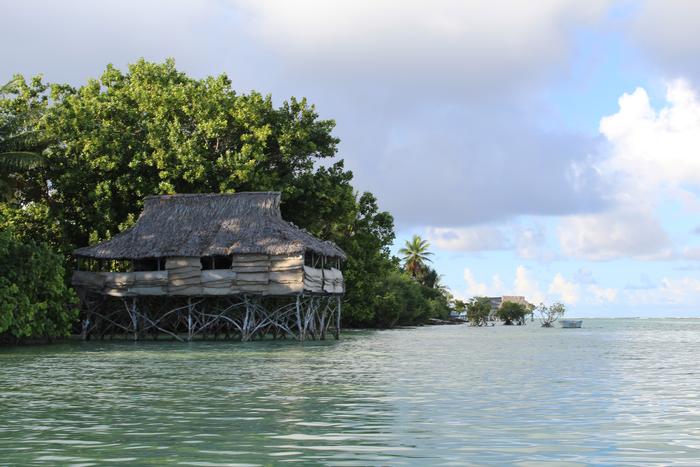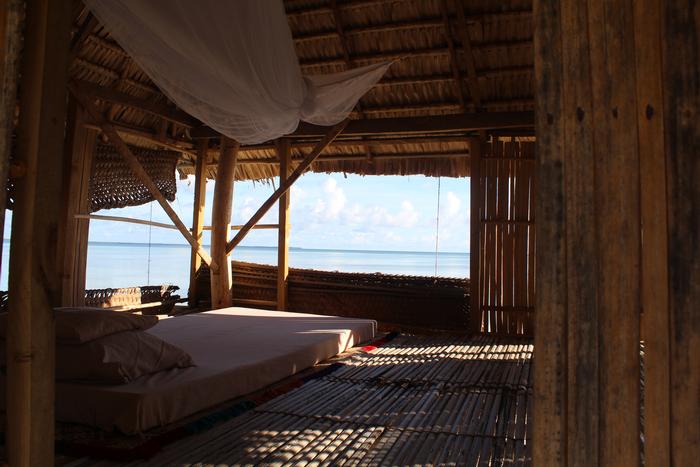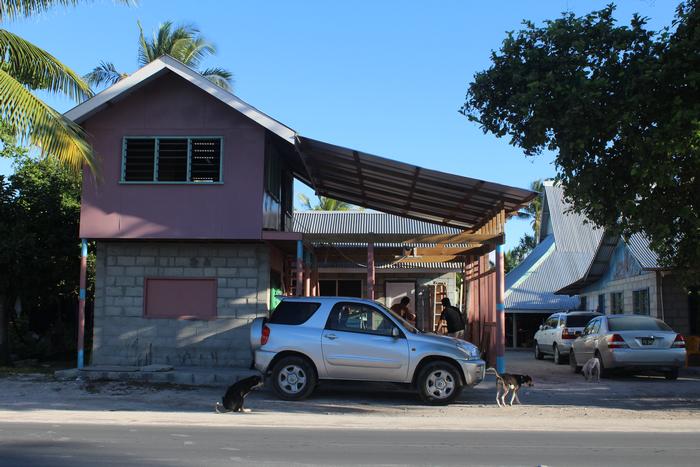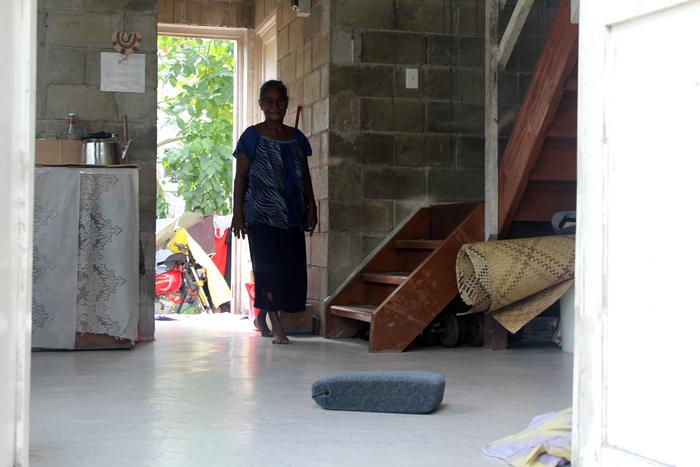[ID:3477] Climate change adaptive design and community-driven resilience in KiribatiUnited Kingdom bibitakin kanoan boong—“change in weather over many days” (i-kiribati for “climate change”)
My interest in sustainable design and the architecture of scarce resources led me to be particularly captivated when I first heard of Kiribati. I first discovered Kiribati as many others have done: through the international news. A small island nation, incredibly remote and almost unheard of are the unlikely first sufferers of climate-change induced sea level rise. As a young designer, my mind instantly imagined possible solutions to their problems: zero-waste, high-tech floating cities, with a new economy that built on the best that the West had to offer. But there were many human questions left unanswered. As I discovered when I first arrived in the islands, the problem is always more complex than is fully appreciated at a conceptual stage. These questions and the urge to design the answers to them led me to Kiribati and see and learn first-hand the situation. Faced with the serious threat of their homes surrendering to the seas, many international commentators see their migration to other nations as inevitable, but the local people, the i-kiribati, proudly disagree. Thus began my ongoing research into the rich fabric of the lives of the i-kiribati people; their culture, their history, their architecture, their way of life and I continue to work in assisting them in their adaptation efforts against increasing threats and an uncertain future. As part of my research, I have been studying and working with Kiribati for 2 years, completing a needs-based assessment, and conducting extensive consultations with the locals in order to better understand the role an architect can play in their ongoing development and climate change adaptation strategies.
The nation of Kiribati comprises of a collection of 33 small islands - all but one of which are coral atolls. These islands are spread across a large portion of the Pacific, a rich, biodiverse and UNESCO-protected stretch of ocean. The locals’ ethnicity is nearly 90 percent pure I-Kiribati, a unique culture deeply embedded in their homelands. Anthropologically, their community-driven lifestyle could be considered idyllic relative to the West’s Gen-Y with Kiribati culture highly centred on kinship and giving, a starkly different approach to our life in the West. A strong sun shines down almost every day, illuminating the lush greenery of palm and pandanus while the crystal blue waters of the lagoons reflect a brilliant blue sky. At first glance it is has all the hallmarks of an island paradise complete with exotic looking timber structures rising out of the water but this is more a vision of what Kiribati could be rather than its lived reality.
Kiribati faces difficulties with a multitude of social issues including education and literacy, high levels of obesity and diabetes. As a Least Developed Country with a population of 120,000, their annual government budget is made up primarily of financial contributions from the World Bank and neighbouring economies such as Japan and Australia. International aid and assistance also come in other forms: the US provide water tanks for rainwater harvesting, the Taiwanese provide vehicles to resurface roads, the Australians build schools, and the EU provides solar panels, to name a few. Various international non-governmental organisations (NGOs) develop strategies and facilitate the implementation of these technologies as well as provide training and support for schools and hospitals.
The I-Kiribati are also especially vulnerable to the ongoing flooding events caused by rising sea levels. All but one island in the Republic is low-lying, with the highest point being only 3m above sea level. With sea levels projected to rise between 2m to 2.7m by 2100 - according to recently re-adjusted surface temperature warming projections - the future for the I-Kiribati is potentially catastrophic. The people of Kiribati are proud, passionate and forward-thinking, and my consultations with local NGOs, interest groups, and high-ranking state officials have revealed that the community is looking to meet their challenges head-on.
Their responsiveness and openness to support from more developed nations has resulted in rapid modernisation which in some ways has led to them skipping and thus avoiding the more negative impacts 20th century industrialisation has had on other developed nations. The main island of Tarawa has used a diesel fuel generator plant to provide most of the power to more urban areas, including telecommunications equipment, but the outer islands are a different story. Electricity is harnessed by either community solar panels or household systems, providing a DC current to charge batteries to power lights at night as well as handheld devices such as tablets and mobile phones. It is common at night to witness I-kiribati relaxing in their te buias, illuminated by battery-powered lights, watching a film on their tablet or messaging friends and family on Facebook. Films can be purchased for a dollar or two at designated re-sellers that download the film to a usb stick for the customer to rent and take home - this is their version of Blockbuster video, but adapted to suit a community without televisions and dvd players. Facebook messenger has become the dominant method of communication, even surpassing email and phone calls - it was the only way I could initially make contacts ahead of my first visit. The Australian dollar is the currency of Kiribati, but the use of paper notes and coins is decreasing in favour of digital phone credits. While driving a motorbike, one can stumble upon a tiny shop in the jungle, and purchase fuel simply by transferring digital credits from your phone to the vendors. It is an exciting experience to find that in a remote community which lives on subsistence farming, their energy can also be harnessed sustainably all the while supported by an excellent 4G phone signal. Their lack of resources has pushed them to be super efficient with what is available and technologies of the West have provided tools with compound benefits, such as the mobile phone which doubles up as both a wallet, an information source and communication aid. Nevertheless, food, water and waste management have been key issues that local government and community groups as well as international NGOs continue to battle with.
While surrounded by vast oceans, droughts can plague the I-kiribati, and they are becoming longer due to climate change. Traditionally, the local people have relied upon natural aquifers of fresh water which float above the water table and are accessed by wells. These become polluted after flooding events which contributes to a high rate of food-borne illnesses in the community.The brackish water, with its bitter taste is mixed with imported white sugar to make it more palatable. This practice however has in turn contributed to high rates of obesity and diabetes from the high-sugar intake. The favoured solution to this problem has to develop strategies and opportunities to harvest rainwater. The traditional Kiribati house with its pandanus leaves hanging down and lack of gutters has not been seen as an ideal candidate for this so newly installed corrugated roofing to protect water tanks, shielding them from the hot midday sun, is used instead as well as through community consultation identified other buildings with metal roofs which allow for effective capture and the set-up of community collection points.
Nearly everything is imported and with an urbanised community large amounts of waste build up. Much of this packaging is not biodegradable and if discarded into the sea builds up on the beaches. More typically on the main island it is collected and buried in landfill which in turn leaches out into the sea. Typically i-kiribati bathe in the sea and also go to the toilet in it too. On the Outer Islands with a sparse population, this causes no problems, but in the densely populated areas on Tarawa such as Betio, sewerage cannot be cleared by the tides so quickly and leads to highly polluted water with toxic stench.
A Tale of Two Houses
The climate of Kiribati is one of constant heat and humidity and building design needs to respond to this. The air temperature closely matches the surrounding oceans with fluctuations year-round of only one degree celsius. Designing for such a climate requires strategies to increase comfort by reducing felt temperatures. The humidity in Kiribati is usually well over 60% which means the body’s natural evaporation method - sweating - is significantly impaired. Air movement helps alleviate this with a breeze that travels at least 0.5m per second reducing felt temperatures by up to three degrees celsius. Heat gain is strongest during the day with the equatorial sun beating down onto roofs and walls, radiating that heat onto those living within.
In the context of Kiribati then, I have identified a few principles as being particularly important for the design of homes:
1. Designing for scarcity: homes that are efficient in their material use and easy to maintain while being conscious of a location with scarce resources; 2. Designing for sustenance: utilising sustainable and locally sourced materials and using methods with compound benefits; 3. Designing for comfort: design that mitigates high temperatures and humidity
The capital island of Tarawa is urbanising faster relative to the Outer Islands, with its new generation of I-Kiribati growing up in a world that is leaving behind past traditional skills and architecture, in favor of Western-sourced solutions. A typical home therefore is a simple single storey concrete block construction, sometimes with a second storey made from cement sheeting (see Fig 3). There are no applied finishes to the interior or the exterior, with the internal space kept clear in order to respond to a variety of uses (see Fig 4). Handwoven mats are laid down to sit on in place of chairs. There are three primary reasons for the popularity of concrete and steel houses: perceived rise in status, as these materials are considered more prestigious having been used so excessively in developed countries; speed of construction, it is much faster to lay concrete blocks to build a wall than erect a timber frame; and ease of maintenance, concrete and steel require little to no maintenance to retain its use for a generation whereas timber and traditional thatched roofs in particular need attention every few years.
In the Outer Islands by contrast, the traditional Kiribati home (as seen in Fig 1) has developed over many generations of local builders and has naturally evolved to respond local requirements. Being a form of lightweight timber construction, they can be easily raised off the ground to protect from vermin or flood events, sometimes even transported inland when high-tide warnings are given. Homes are built using locally sourced timbers such as coconut palm and pandanus and lashed together with twine made from the husks of coconuts. At night, the differential in temperature from the lagoon in the centre of each atoll to the surrounding oceans creates cooling breezes that are capitalised on by moveable wall partitions creating a cross ventilation effect (see Fig 2). High roofs that have absorbed the heat of the sun during the day are ventilated at high level away from the occupants.
Contemporary construction methods do not respond to the design principles above but rather compound the problems i-kiribati face. Steel and concrete need to imported creating waste and pollution as a result. Concrete block homes are not raised off the ground and are thereby easily susceptible to floods during high tides. Concrete also retains heat over the day, releasing heat overnight with its high thermal mass. This makes for an uncomfortable sleeping environment, resulting in many families ironically opting to sleep outside in their kia kia or open air timber hut, rather than in their new homes. The traditional te buia however adheres to all these principles, though further improvements on the design can be made.
Faced with current climatic and social challenges, I would therefore suggest a couple of additional principles:
4. Designing for adaptation/resilience: to provide solutions which are readily flexible at short notice to extreme events. 5. Designing for identity: identifying that a home is a reflection and expression of the inhabitants, both in how they see themselves and their connection to society
Remembering Something Almost Forgotten
A need for a re-appraisal of traditional construction methods for the next generation of i-kiribati can be compared to the current community-led approaches tackling the social issues surrounding health. At the Kiribati Health Retreat, a group of young volunteers devote their time massaging the elderly and infirm that suffer from gout, while treating them to fresh juices. Their response to the issues of the community however have led them to be less passive in their treatments, and more active. They now host traditional cooking lessons uses local ingredients and teach healthy lifestyle tips. Patients on more urbanised Tarawa are instructed to collect noni fruit and bring them in where they are turned into juice - an alternative medicine elixir for a variety of ailments. Though the evidence for the effectiveness of noni juice has not been established, their efforts have been instrumental in empowering both young and old to take greater advantage of, and in turn give greater respect to, their natural resources. Traditional cooking is turned into a spectacle for a new generation of i-kiribati that capture the process on their phones and tablets to try at home.
The architect can work as an enabler to break down the hurdles that prevent positive social change from occurring. Hamdi writes of the benefits of “emergence” and the benefits of reading the underlying narratives of a place, pinpointing bottlenecks to positive change and relieving these through small interventions. Over time this cultivation will then facilitate an emergence of a positive and productive community. As architects and planners we need to “act spontaneously, to improvise and to build in small increments”.
Younger generations garner their information in new ways and in different forms. Knowledge passed down over generations through oral traditions can be captured and made more palatable to a digital generation. Traditional methods can be re-appraised on their own merits, with those most fit for purpose turned into standard details and turned into bite sized YouTube videos or short training courses.
The indigenous design of Kiribati is so developed and unique that it should continue to be celebrated and used rather than supplanted with kit solutions. Kit-set homes and schools have been deployed by various NGOs and while they mitigate a desperate shortage, their role is best kept for short term needs. Time is a cultural construct and something that can be erected faster does not always provide the best solution for the long term. If traditional knowledge can be better adapted to provide solutions faster, and there was a greater base of building knowledge in the community, then like their preferred farming methods, they could be subsistence builders as well.
As a young designer, I have learnt through my research that the best outcomes are not always the fantastic futures that we can dream up, but sometimes require being humble and re-evaluating the past instead. The fragile and closed ecosystem of Kiribati has its own lessons to teach which can no doubt help other similarly financially disadvantaged nations dealing with flood events. Subsistence farming is inherently a self-reliant, sustainable way to manage food on a local scale. By applying the same ideas to construction, Kiribati can start to turn away from a reliance on imported materials and better manage and utilise the resources they are naturally gifted with. By looking to and learning from the past, and integrating a shared skill set, inter-generational links are made, cultural identity is strengthened and this in turn brings a community together, ready to fight large challenges such as climate change.
My aim here is to challenge existing patterns of thought when dealing with complex local problems, by combining the optimal user-cases of Western technologies and adapting it through local knowledge - which has evolved from centuries of natural selection and trial-and-error. As designers, we should take a step back and realise that our devised solutions may not always take into account unexpected grassroots needs. Perhaps, by better using our ‘soft’ powers, we can provide greater and more sustainable change.
References list (outside 2500 word limit):
“Least Developed Country Category: Kiribati Profile | Development Policy & Analysis Division,” United Nations (United Nations)
Koch, Gerd, The Material Culture of Kiribati (Suva, Fiji: Institute of Pacific Studies of the University of the South Pacific, 1986)
Ministry of Finance & Economic Development, Republic of Kiribati Kiribati Development Plan 2016 to 2019 (2016)
Hamdi, Nabeel, Small Change: about the Art of Practice and the Limits of Planning in Cities (London: Earthscan, 2009)
Nunn, Patrick D., “The End of the Pacific? Effects of Sea Level Rise on Pacific Island Livelihoods,” Singapore Journal of Tropical Geography, 34 (2013), 143–71
Strickland, Ashley, “Earth to Warm 2 Degrees Celsius by the End of This Century, Studies Say,” CNN (Cable News Network, 2017)
Walker, Brian, and David Salt, Resilience Thinking Sustaining Ecosystems and People in a Changing World (Washington: Island Press, 2006)
If you would like to contact this author, please send a request to info@berkeleyprize.org. |




